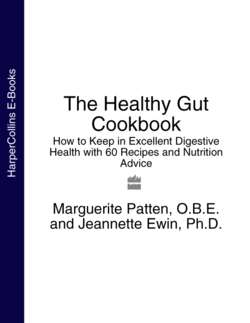Читать книгу The Healthy Gut Cookbook: How to Keep in Excellent Digestive Health with 60 Recipes and Nutrition Advice - Marguerite Patten - Страница 17
fibre – a rough guide
Оглавление• Build your meals around fruits and vegetables.
• Add foods high in complex carbohydrates (such as wholemeal pasta and bread, potatoes, rice, maize).
• Enjoy a single serving of high-protein foods (meat, eggs, dairy products, soya) at each meal.
• Top it off with a little of what you fancy. Unless you have a known medical condition that prohibits this luxury, a glass a wine or a small dish of ice cream will not break the nutritional bank.
• Cut down your intake of deep-fried and other fatty foods and refined carbohydrates (white bread and pasta, sugar), and limit your alcohol consumption. These foods are liabilities when it comes to good gut health.
Just like any other part of the body, a healthy gut requires a balanced intake of foods supplying the full complement of essential vitamins and minerals, proteins, carbohydrates and fats. In fact, the gut needs a more constant flow of nutrients than many other organ systems because the processes of digestion scour surface cells from the gut lining at an amazing rate: the lining of the gut is replaced every 72 hours. This rapid turnover increases its vulnerability to ulceration and inflammation.
What sets the nutritional needs of the gut apart is its need for fibre. This indigestible form of carbohydrate ferments in the gut with the help of local bacteria, and provides the bulk needed to push waste materials from the body. Fruits, vegetables, whole grains, nuts and seeds supply fibre, making them essential for a balanced diet. Most experts tell us that a balanced diet includes at least five portions of fruit and vegetables a day because these foods are rich sources of necessary nutrients, and because they are an excellent source of soluble fibre (the differences between soluble and insoluble fibre are discussed below).
The composition of a balanced diet is a hotly debated issue. As this book is being written the main excitement among slimmers concerns low-carbohydrate/high-protein diets; these appear to miraculously shift the body’s chemistry so that unwanted fat melts away. This is an attractive idea seized upon by millions, but it has a drawback. Eating low-carbohydrate foods means restricting the consumption of fibre, and this can lead to the most common form of gut complaint: constipation. If you read Chapter 5, about diverticulitis and the various health problems involving constipation, you will see why this common condition should be avoided. There are ways to get around problems presented by low-carbohydrate diets. Laxatives are the most popular solution – but they can become habit forming and do not provide the benefit of minerals and vitamins found in a well-balanced diet.
High-protein diets are only one reason the problem of constipation is accelerating. The modern Western diet invites trouble by being based on foods that are low in fibre and high in refined sugar and saturated fats – all of which are bad for the gut. As a result, every day more of us are afflicted by indigestion, gastric ulcers, flatulence, diverticulitis and constipation, leading to serious bowel disease, including cancer. Both soluble and insoluble fibre help reduce this risk. Eating brown rice, bran and nuts provides insoluble fibre. Fresh fruits and vegetables, brown bread, oats and pulses are rich sources of soluble fibre. Dried fruits and whole grains provide both. When planning a balanced diet, include sources of both types of fibre.
There are significant differences in the two types of fibre. Insoluble fibre has no known health benefit other than providing bulk to discourage constipation. Like the soluble form, it consists of complex and indigestible carbohydrates. To a limited extent, insoluble fibre helps sustain the normal bacterial flora of the gut, which also add to the weight and bulk of the waste – or stool – as it works its way through the lower bowel. Without bulk, the muscular walls of the intestine get flabby and relaxed, and fail to be efficient.
Soluble fibre, on the other hand, gives up its form and dissolves in the watery environment of the digestive system. Consider what happens when you prepare porridge. As the oats cook and pieces of grain swell, the simmering water or milk begins to thicken and become viscous due to the release of soluble fibre. In the gut, the same molecules that thicken the porridge can absorb various substances (such as bile) during digestion, preventing their transfer into the bloodstream. Considerable research evidence suggests that this nutritionally inert substance not only supports good gut health, but also helps reduce blood cholesterol levels and prevents sharp fluctuations in blood sugar.
